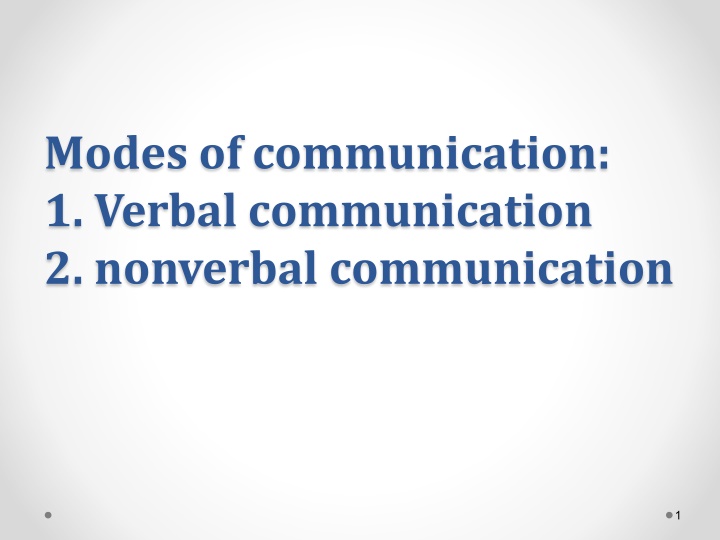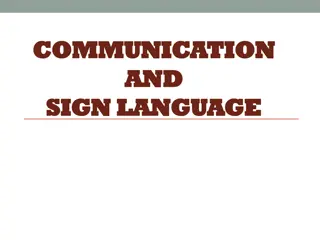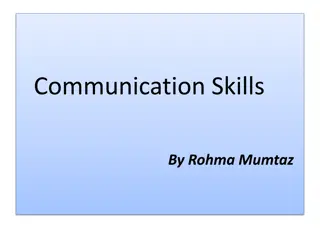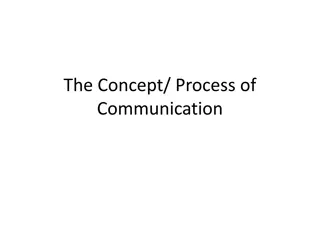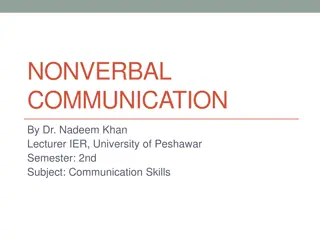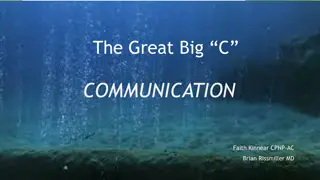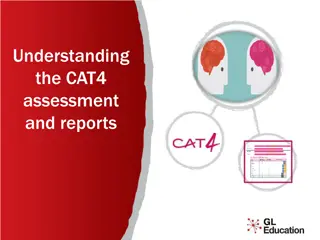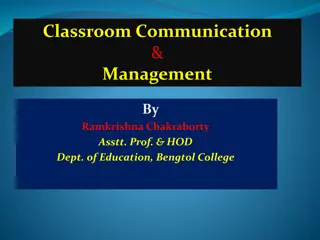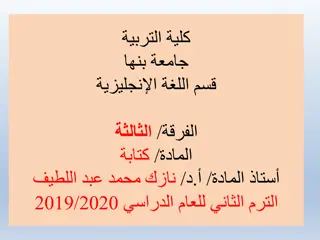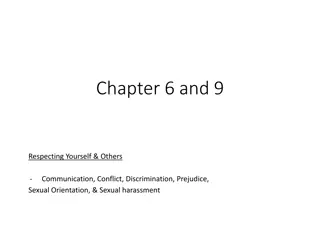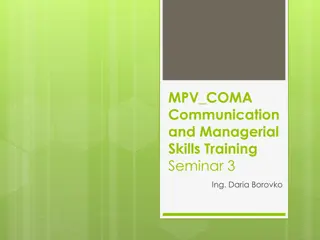Modes of Communication and Verbal Messages
Communication occurs through verbal and nonverbal modes, with messages having denotative and connotative meanings. Verbal messages vary in directness, affecting the effectiveness of communication. Indirect messages offer advantages such as politeness and avoiding offense, but can also lead to misunderstandings. Gender and cultural differences influence the directness of communication styles.
Download Presentation

Please find below an Image/Link to download the presentation.
The content on the website is provided AS IS for your information and personal use only. It may not be sold, licensed, or shared on other websites without obtaining consent from the author.If you encounter any issues during the download, it is possible that the publisher has removed the file from their server.
You are allowed to download the files provided on this website for personal or commercial use, subject to the condition that they are used lawfully. All files are the property of their respective owners.
The content on the website is provided AS IS for your information and personal use only. It may not be sold, licensed, or shared on other websites without obtaining consent from the author.
E N D
Presentation Transcript
Modes of communication: 1. Verbal communication 2. nonverbal communication 1
MODES OF COMMUNICATION Communication occurs in a variety of ways: through words, actions, or a combination of words and actions. When there is congruence ( a match ) between one s words and actions, communication is enhanced. Modes of communication include verbal and nonverbal communication.
PRINCIPLES OF VERBAL MESSAGES Messages are denotative & connotative Messages vary in directness Messages vary in abstraction Message meanings are in people Messages meanings depend on context Messages vary in inclusion 3
Messages are denotative & connotative Denotative: ( The objective definition): refers to the meaning that you would find in dictionary. It s the meaning members of the culture assign to a word. Connotative: ( The subjective meaning): it is the emotional meaning that speakers / listeners give to a word. E.X. The word death for a doctor means when the heart stops. For a mother, emotional feelings that she recalls of her son s youth, illness and so on. 4
Messages vary in directness Indirect messages: attempts to get the listener to say or do something without committing the speaker. ( ex: isn't it cold ?) Direct messages: Express the speaker's preferences clearly (ex: Ali , please close the window). 5
Advantages of indirect messages 1- Allow you to express a thought without offending anyone. 2- Allow you to observe the rules of polite interaction. e.g: instead of saying I am bored with this group you say It s getting late and I have to get up early tomorrow 3- Allow you to ask for compliments in socially acceptable manner. Disadvantages of indirect messages Can create problems due to misunderstanding.
Gender & cultural differences in directness Women are indirect in making requests and giving orders. This indirectness communicates powerlessness, a discomfort with authority. Women for example are more likely to say: it would be great if these letters would go out today 7
Gender & cultural differences in directness Men are direct sometimes to the point of being blunt or rude. However men are more likely to speak indirectly in expressing emotions other than anger, reveal weakness, a problem or admit an error.
Messages vary in abstraction Effective verbal messages include words that range widely in abstractness. At times a general term may suit your needs best, at other times a more specific term serves better
Message meanings are in people If you want to know the meaning of word love you turn to the dictionary affection felt for a person, attraction, desire for person who arouse admiration . The denotative meaning. But if you want to know what Ali mean when he says I'm in love you should turn to Ali to discover his meaning.
So meanings are not in words but in people. As you change, the meaning in people is also change. Example if someone said I love you created certain meaning but when you heard that the same word was said to three other people you drastically change the meaning you draw from these three words.
Messages meanings depend on context According to the context the meaning of any verbal or nonverbal behavior is determined In terms of verbal messages the same words may have different meanings when they occur in different context. Example how are you? means hello if you ask it in the street , but means different if you are in a hospital. Cultural context is important in massages meanings.
Messages vary in inclusion Do you include every present person in your messages? Some messages are inclusive, they include all people present and they acknowledge the relevance of others. You see messages of exclusion in the use of in- group language in the presence of an out group member. ex when doctors get together & discuss medicine, there's no problem, when there is someone who is not a doctor they often fail to adjust to that new person and continue talking about medicine.
Messages vary in inclusion- Cont. Another form of exclusion using terms of own cultural group as universal terms that can be applied to everyone. Example using the mosque or church when the audience are from different religions. Try to find ways to include everyone in the interaction by filling in relevant details for those who are unaware of topic or try to include them by drawing an analogy from their fields. E.g. use alternative terms such as the word place of worship instead of use church or mosque, committed relationships instead of marriage.
Disconfirmation It is the communication pattern in which you ignore someone's presence as well as that person's communications. -Ex this person & what he has to say are not important or not worth serious attention . This person s contribution is unimportant or insignificant that there is no reason to concern yourself with them.
Rejection Different than disconfirmation. You disagree with the person. You indicate your unwillingness to accept something the other says or does. In disconfirmation however you deny the person s significance; everything related to that person doesn t count
Confirmation It is the opposite communication pattern of disconfirmation. You not only acknowledge the presence of the other person, but also indicate your acceptance of this person.
Examples disconfirmation rejection & confirmation Why are you so angry? You get late last week. Stop screaming. I'll do what I want (Rejection). You have a right to be angry. I should tell you that I will be late. ( Confirmation) Deny the person significances. (Disconfirmation) 19
Sexism Widespread expression of sexism is called sexist language. Language that puts down someone because of his or her gender. Guidelines for nonsexist ( gender free, gender neutral or fair) was developed. These guidelines concern the use alternatives to generic man person . (e.g. police officer instead of police man). Generic he\she and his\here, (e.g. the average student is worried about his grade VS; the average student is worried about grades. Talk plural so as to include sexes. 20
Sexism- cont. Do not use sex role Stereotyping: the word you use often reflect a sex role bias The assumption that certain roles or professions belong men and others belong to women shall be avoided: 1. E.g. when you refer to elementary school teacher as female and the college professor as a male. 2. E.g. When you refer to nurse as a female and to the doctor as a male Use appropriate pronoun. e.g. female nurse ,male doctor or vice versa 21
Conceptual distortion () Using verbal messages might be susceptible to conceptual distortion which is: Mental mistakes Misinterpretations or Reasoning fallacies (misjudgment) Therefore avoiding these distortions requires more critical realistic analysis to improve your own use of verbal messages 22
General principles of verbal messages To explore conceptual distortion we examine three general principles of verbal messages: Messages symbolize reality but are not the reality itself Messages can express facts and /or inferences but may not always make the necessary distinction between these two types of statements Messages can obscure important distinctions 23
Messages symbolize reality, it's not reality itself. Consider the following to understand this first principle: Have you ever react to the way something was labeled or described rather than the actual item? Have you ever bought something because of its name rather than because of the actual object? 24
Messages symbolize reality, it's not reality itself- Cont. Intentional orientation refers to our tendency to view people, objects and events in a way they are talked about or labeled. E.g. trade marks ,cosmetic or major stores E.g. Sally is labeled as uninteresting , you respond intentionally and evaluate her as uninteresting. Extensional orientation: tendency to look first at actual people ,object ,and event and only afterwards at their labels. keep your mind free of any preconceived ideas. 25
A related distortion is to forget that language symbolize only a portion of reality never the whole. So a person might be in one of the two patterns: Allness: When you assume that you can know all or say all about anything. This is what you think but the reality is: You never see all of anything, you never experience anything fully, you see a part then conclude what the whole is like. Nonallness : When you recognize that language symbolizes only apportion of reality not the whole. In this situation whatever a person says regardless of what it is or how extensive you believe, it is only a part of the story. 26
Messages express facts & inferences There are two types of statements Factual statement : A statement that you make only after you observe the person or event and limited to what you have observed. E.g. She is standing on the stairs Inferential statement: A statement that can be made without observation or go beyond what you have observed; It is a guess. E.g. She is feeling uncomfortable on the stairs Barriers to clear thinking can be created when inferences are treated as facts a tendency called : Fact- inference confusion 27
Messages express facts & inferences- Cont. Lying: Is an intentional inferential pattern in which one person intends to mislead another by verbal and nonverbal communication Why lying? Lie to make another person feel good Lie to enable another person to save face Lie to get what you deserved but couldn't get any other way. Lie to get your self out of an unpleasant situation. 28
Messages can obscure( )distinction Messages can obscure distinctions both by generalizing about people or events that are covered by the same label but are really quite different. When you allow the general term to obscure the specific differences, you are into a pattern called indiscrimination 29
Indiscrimination It is the failure to distinguish between similar but different people , objects or events. It occurs when you focus on the classes and fail to see that each phenomenon is unique and needs to be looked at individually. Example: group together teachers, students politicians, such terms lead you to focus on similarities, at the same time the term divert attention away from the uniqueness of each person This kind of misevaluation is the heart of stereotyping Stereotyping is: A fixed mental picture of a group that is applied to each individual in a group without regard to his or her unique qualities 30
Indiscrimination- Cont. To treat indiscrimination use the antidote which is the index Index : is mental subscript identifies each individuals as an individual even thought both may covered by the same label Avoid stereotypes, e.g: Americans are intelligent. African American are criminals Muslims are terrorists 31
Messages can obscure( )distinction- Polarization Using Polarization in Messages can obscure distinction Polarization is: The tendency to look at the world in terms of opposites and to describe it in extremes Referred to as fallacy of either black or white There is a tendency to view only the extremes and categorize people objects and events in terms of those polar opposites Example: extremes such as: Good, Bad Positive, Negative However the middle ground terms that reflects the situation in the middle are few . This creates a problem when we use the opposites in inappropriate situations. For example some times I am not good but I am not bad however I am in between. Happy, Unhappy 32
Definition of nonverbal communication It define as communication without words by using several signals like posture , smile or frown , touch someone, raise your vocal volumeor even say nothing . ,widen your eyes ) (
Good Body Language is Essential for Good Communication 35
The Benefits of competency in non verbal communication 1.The greater your ability to encode and decode non-verbal signals, the higher your popularity and psychological wellbeing are likely to be. Encoding and decoding are highly correlated: if you are good at expressing yourself nonverbally then you are likely to be good at reading the nonverbal cues of others.
The competency in non verbal communication has two benefits- Cont. 2. The greater your nonverbal skills, the more successful you are likely to be at influencing and deceiving others. In other words skilled nonverbal communicators are highly persuasive. This persuasive power can be used to help or support others or it can be used to deceive and fool.
The function of nonverbal messages To understand the functions of nonverbal messages you should look at the Integration of nonverbal & verbal messages. It can be explained as:
Integration of nonverbal and verbal messages 1) Serves to accent or emphasize( e.g. raise your voice to underscore a particular word or phrase ,bang your fist on the desk to stress your commitment) 2) Complement or add hints of meaning not communicated by your verbal messages( e.g. smile while telling story to suggest that you find it funny). 3) Regulate: to control or indicate your desire to control (e.g. to make a hand gesture to indicate that you want to speak).
Integration of nonverbal and verbal messages- Cont. 4) repeat: restate the verbal messages nonverbal ( e.g. raised your eye brows , is that right?). 5) substitute: replace the verbal messages with nonverbal( e.g. you can signal OK with a hand, shake your head to indicate no ). 6) contradict verbal messages with nonverbal movement ( e.g. crossing your fingers when you are lying).
Nonverbal communication Functions 1.Forming and managing impression about person body, skin color, dress eye contact .Also it reflect credibility of person likeability ,attractiveness and dominance or power . 2.Forming and defining relationship ( you communicate nature of relationship) as holding hands or dressing alike . 3.Structuring conversation and social interaction by nodding head toward another person giving the signal that you give this person the turn to speak.
Functions Cont. 4.Influence and deception (gestures that explain what you are saying). Deception the ability to deceive ,to lie or to mislead another person to thinking something is true when its false. 5.Emotional expression( nonverbal expressions about emotion e.g. happiness, sadness.).Use the non-verbal communication with unpleasant messages.
The channels of nonverbal messages. 1)Body messages. 2)Face messages. 3) Eye messages . 4) Spatial messages 5) Artifactual messages 6) Touch messages 7) Silence messages 8) Time messages 9) Smell messages
Body messages- Body movements Major types of body movements: 1- Emblems are body gestures that directly translate into words or phase ( e.g. OK for good job or V for victory). 2- Illustrators ( e.g. point your arm to the left means turn to the left). 3- Affect displays ( movements of the face e.g. body tension or relaxation.).
Facial messages It communicate the eight primary emotions( happiness, surprise, fear, anger, sadness, disgust, contempt (dislike), interest). Cultural display rules e.g. American students displayed facial expression but Japanese are not. e.g. Japanese women aren't supposed to reveal broad smiles, they hide their smile.
Facial management techniques Used to communicate feelings to achieve the effect you want. Help people to display emotion In socially acceptable manner and polite interaction o Intensify or exaggerate feeling: intensify or minimize feeling cover up your joy in presence of friend who received bad news o Neutralize or cover or hide a feeling (cover up your sadness to keep from depressing others) o Mask or replace his expression of one emotion for another express happiness in order to cover up your disappointment o Simulate express an emotion you don t feel..
Eye messages These messages depend on duration, direction & quality . *purposes of eye contact :- - Request for feedback through and after conversation . - Nature of relationships ,positive or negative relationship. - Eye contact enable you to psychologically lessen the physical distance between your self and other person .
Eye Messages 50
